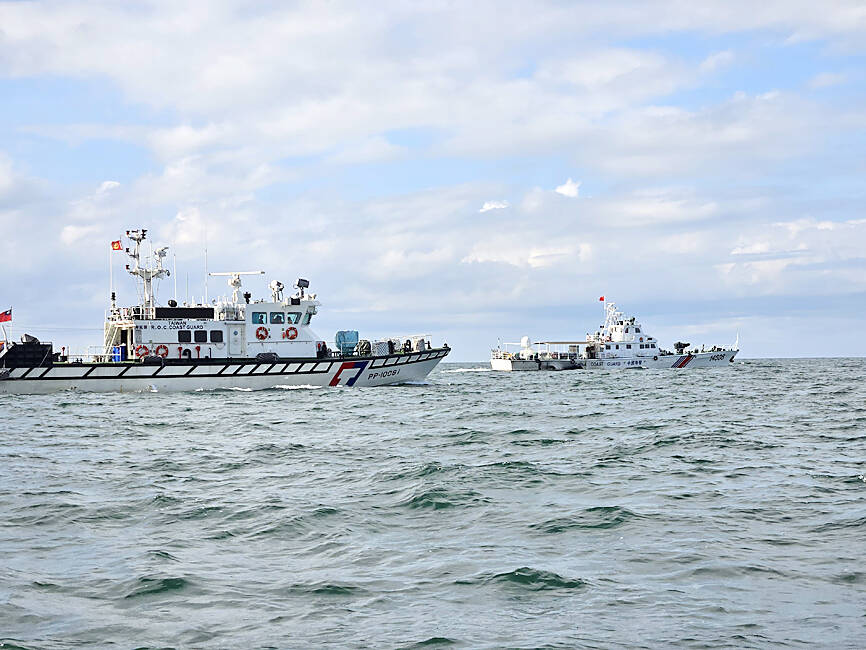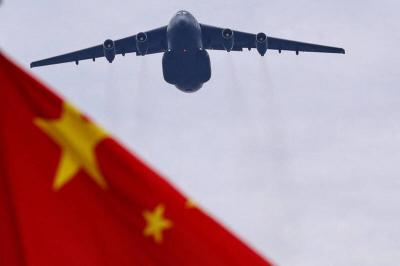President William Lai (賴清德) yesterday vowed to continue to strengthen the nation’s defenses, as China sent the year’s biggest batch of warplanes near Taiwan to join drills with its Shandong aircraft carrier in the western Pacific.
“The Chinese Communists’ threat to regional stability continues to rise, and its gray zone intrusions into the Taiwan Strait and surrounding areas are also increasing day by day, which are a challenge to global democracy,” Lai told military officers in Taipei.
A total of 56 Chinese warplanes crossed the median line of the Taiwan Strait or an extension of it between 5am on Wednesday and 6am yesterday, the Ministry of National Defense said.

Photo courtesy of the Coast Guard Administration
The planes flew into the northern, southeastern and southwestern parts of the nation’s air defense identification zone (ADIZ), it said.
They were part of a larger fleet of 66 Chinese aircraft detected around Taiwan en route to join the Shandong, it added.
Of the 56 aircraft, some flew as close as 33 nautical miles (61km) from Oluanpi (鵝鑾鼻) on Taiwan’s southernmost tip, flight paths released by the ministry showed.
As of Wednesday morning, the Shandong had transited through the Balintang Channel north of the Philippines, the ministry said.
The Chinese military exercises coincide with a NATO summit in Washington.
Su Tzu-yun (蘇紫雲), a research fellow at the state-run Institute for National Defense and Security Research, said that some of the flight paths were unusual.
He was referring to 26 aircraft that flew southwest to northeast through the southeastern ADIZ before again changing direction and leaving the area.
The flight path was unusual, as Balintang Channel is southeast of Taiwan, he said.
The planes likely took this unusual path deliberately, in response to the inauguration of American Institute in Taiwan Director Raymond Greene earlier this week and his scheduled meeting with Lai on Wednesday, Su said.
A Japanese destroyer also made a rare entry into China’s territorial waters near Taiwan this month without notifying China, sparking “serious concerns” from Beijing, Japanese media reported on Wednesday.
Also yesterday, the Coast Guard Administration (CGA) said it shadowed four China Coast Guard vessels that intruded into Taiwan-controlled waters around Kinmen County.
The four Chinese vessels approached the outer boundary of “restricted” waters around Kinmen and entered the Taiwan-controlled waters at 7am from four different points, the CGA said in a statement.
The intrusion was the first this month and 31st this year, it said.
The Chinese ships left the restricted waters at 9am only to re-enter at 10am, when the CGA again dispatched four vessels in response.
The Chinese vessels left Taiwan-controlled waters between noon and 1pm, it said.

Beijing could eventually see a full amphibious invasion of Taiwan as the only "prudent" way to bring about unification, the US Department of Defense said in a newly released annual report to Congress. The Pentagon's "Annual Report to Congress: Military and Security Developments Involving the People's Republic of China 2025," was in many ways similar to last year’s report but reorganized the analysis of the options China has to take over Taiwan. Generally, according to the report, Chinese leaders view the People's Liberation Army's (PLA) capabilities for a Taiwan campaign as improving, but they remain uncertain about its readiness to successfully seize

Taiwan is getting a day off on Christmas for the first time in 25 years. The change comes after opposition parties passed a law earlier this year to add or restore five public holidays, including Constitution Day, which falls on today, Dec. 25. The day marks the 1947 adoption of the constitution of the Republic of China, as the government in Taipei is formally known. Back then the Chinese Nationalist Party (KMT) governed China from Nanjing. When the KMT, now an opposition party in Taiwan, passed the legislation on holidays, it said that they would help “commemorate the history of national development.” That

Trips for more than 100,000 international and domestic air travelers could be disrupted as China launches a military exercise around Taiwan today, Taiwan’s Civil Aviation Administration (CAA) said yesterday. The exercise could affect nearly 900 flights scheduled to enter the Taipei Flight Information Region (FIR) during the exercise window, it added. A notice issued by the Chinese Civil Aviation Administration showed there would be seven temporary zones around the Taiwan Strait which would be used for live-fire exercises, lasting from 8am to 6pm today. All aircraft are prohibited from entering during exercise, it says. Taipei FIR has 14 international air routes and

Snow fell on Yushan (Jade Mountain, 玉山) yesterday morning as a continental cold air mass sent temperatures below freezing on Taiwan’s tallest peak, the Central Weather Administration (CWA) said. Snowflakes were seen on Yushan’s north peak from 6:28am to 6:38am, but they did not fully cover the ground and no accumulation was recorded, the CWA said. As of 7:42am, the lowest temperature recorded across Taiwan was minus-5.5°C at Yushan’s Fengkou observatory and minus-4.7°C at the Yushan observatory, CWA data showed. On Hehuanshan (合歡山) in Nantou County, a low of 1.3°C was recorded at 6:39pm, when ice pellets fell at Songsyue Lodge (松雪樓), a